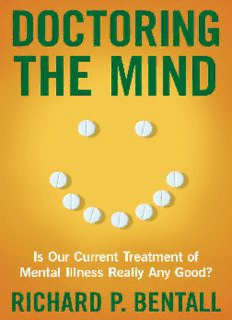
Doctoring the Mind: Is Our Current Treatment of Mental Illness Really Any Good? PDF
Preview Doctoring the Mind: Is Our Current Treatment of Mental Illness Really Any Good?
Doctoring the Mind This page intentionally left blank Doctoring the Mind Is Our Current Treatment of Mental Illness Really Any Good? Richard P. Bentall (cid:4) New York University Press Washington Square, New York This book is dedicated to Sarah Butler sister and friend First published in the U.S.A. by NEW YORK UNIVERSITY PRESS Washington Square New York, NY 10003 www.nyupress.org © 2009 by Richard P. Bentall All rights reserved Library of Congress Cataloging-in-Publication Data Bentall, Richard P. Doctoring the mind : is our current treatment of mental illness really any good? / Richard P. Bentall. p. cm. Includes index. ISBN–13: 978–0–8147–9148–6 (cl : alk. paper) ISBN–10: 0–8147–9148–4 (cl : alk. paper) 1. Mental illness. 2. Mental illness—Treatment—Evaluation. I. Title. RC454.B452 2009 616.89—dc22 2009014687 New York University Press books are printed on acid-free paper, and their binding materials are chosen for strength and durability. We strive to use environmentally responsible suppliers and materials to the greatest extent possible in publishing our books. Manufactured in the United States of America 10 9 8 7 6 5 4 3 2 1 Contents ListofIllustrations vii ListofFigures viii Acknowledgements ix Preface:RationalAntipsychiatry xi Part One: An Illusion of Progress 1 ASmashingSuccess? 3 2 TheApplianceofScience:TheEmergenceofPsychiatry asaMedicalDiscipline 26 3 TherapeuticInnovationattheEndoftheAsylumEra 42 4 DissentandResolution:TheTriumphofBiological Psychiatry 69 Part Two: Three Myths about Mental Illness 5 PeopleorPlants?TheMyththatPsychiatricDiagnoses areMeaningful 89 6 TheFundamentalErrorofPsychiatry:TheMyththat PsychiatricDisordersareGeneticDiseases 113 7 Brains,MindsandPsychosis:TheMyththatMental IllnessesareBrainDiseases 148 Part Three: Medicine for Madness 8 Science,ProfitandPoliticsintheConductofClinical Trials 185 v contents 9 LessisProbablyBetter:TheBenefitsandCostsof Antipsychotics 214 10 TheVirtueofKindness:IsPsychotherapyEffective forSevereMentalIllness? 242 11 WhatKindofPsychiatryDoYouWant? 262 Notes 289 Index 351 vi List of Illustrations Photographicacknowledgementsaregiveninparentheses. 1 SoteriaHouse(TheSocietyforLaingianStudies) 24 2 EmilKraepelin(1856–1926),psychiatrist,scientistand Germannationalist(NationalLibraryofMedicineScience PhotoLibrary) 29 3 WalterFreemanchangesHowardDully’smind(WGBH Boston) 38 4 HenriLaborit(1914–1995)(SophieBassouls/Sygma/Corbis) 45 5 B.F.Skinner(1904–1990)(Bettmann/Corbis) 54 6 CarlRogers(1902–1987)(NatalieRogers) 59 7 RonaldLaing(1927–1989)(EstateofFayGodwin/National PortraitGallery,London) 71 8 ThomasSzazs(1920– )(DavidLees/Corbis) 72 9 JamesLind(1716–1794)andSirAustinBradford Hill(1897–1991)(WellcomeLibrary,London) 192 vii List of Figures 1 Thepossibleevolutionofparanoidbeliefs 169 (adaptedfromD.FreemanandR.P.Bentall(eds.)(2008), PersecutoryDelusions:Assessment,TheoryandTreatment (OxfordUniversityPress,2008)) 2 Amodelofparanoia 176 (adaptedfromR.P.BentallandC.Fernyhough(2008), ‘Socialpredictorsofpsychoticexperiences:Specificityand psychologicalmechanisms’,SchizophreniaBulletin,34, 1009–11) 3 Amodelofauditoryhallucinations 181 (adaptedfromR.P.BentallandC.Fernyhough(2008), ‘Socialpredictorsofpsychoticexperiences:Specificityand psychologicalmechanisms’,SchizophreniaBulletin,34, 1009–11) 4 CONSORT diagram 204 (adaptedfromN.Tarrier,S.Lewis,G.Haddock, R.P.Bentall,R.Drake,G.Dunn,etal.(2004)‘18-month follow-upofarandomizedcontrolledtrialofcognitive- behaviourtherapyinfirstepisodeandearlyschizophrenia’, BritishJournalofPsychiatry,184:231–9) viii Acknowledgements As usual I must thank my numerous postgraduate students and col- leaguesinclinicalpsychologyandpsychiatryforstimulatingmythink- ingabouttheissuesdiscussedinthefollowingchapters.Ofmycurrent and recent postgraduates, I would like to mention Eve Applegate, Hazel Dunn, Paul French, Becca Knowles, Sara Melo, Michael Moutoussis, Justin Thomas, Alisa Udachina and Filippo Verase. Of my colleagues I would like to mention, in clinical psychology, Tony Morrison, Mike Jackson, Steve Jones, John Read and Sara Tai, in biomedicalstatisticsGrahamDunn,ChrisRoberts,PaulaWilliamson and Gill Lancaster, and, in psychiatry, Shoˆn Lewis, David Kingdon, David Linden, Richard Morriss, Jan Scott and Richard Drake (who, I guess, would disagree with much of what I have written but who seem to be relaxed about collaborating with someone who has one foot in the antipsychiatry camp). I would also like to thank my assistant Hanneke Booij for keeping me organized during my first extremelybusyyearatBangor.Aspecialmentionshouldalsobegiven toPeteSaundersofPCCSBooks(asmallpublishinghousespecializing in books about psychotherapy) for alerting me to the contribution of Carl Rogers, which has almost been forgotten by most clinical psychologists. Self-evidently, none of these people should be held in any way responsible for any errors I have made. Perhaps one of the greatest joys of an academic life is that it allows one to work in friendly cooperation with talented people whose views on important issuesareoftencompletelydifferentfromone’sown. I would like to thank my wife Aisling, a clinical psychologist who worksinanearlyinterventionservice,forhersupportandforendless discussions about service users, their problems and their aspirations. ix
Description: